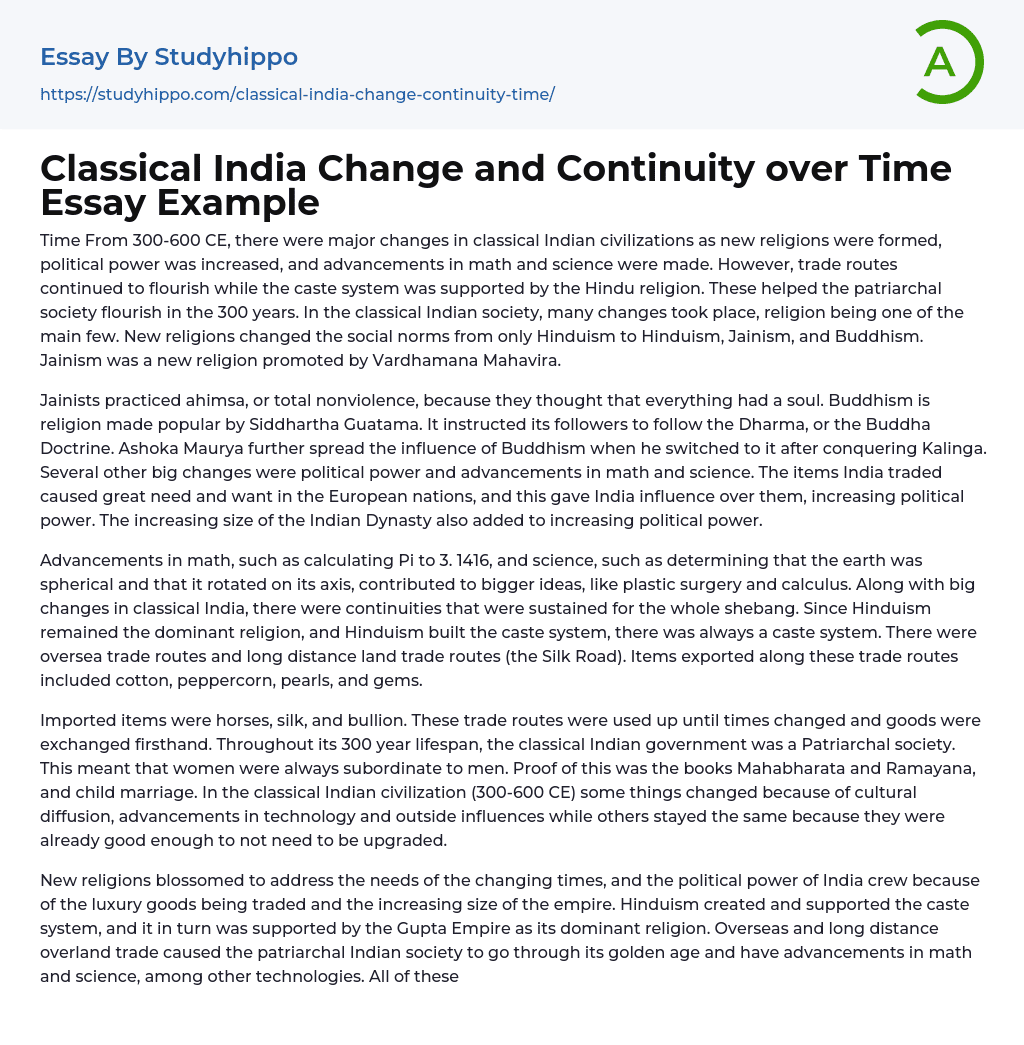Time From 300-600 CE, there were major changes in classical Indian civilizations as new religions were formed, political power was increased, and advancements in math and science were made. However, trade routes continued to flourish while the caste system was supported by the Hindu religion. These helped the patriarchal society flourish in the 300 years. In the classical Indian society, many changes took place, religion being one of the main few. New religions changed the social norms from only Hinduism to Hinduism, Jainism, and Buddhism. Jainism was a new religion promoted by Vardhamana Mahavira.
Jainists practiced ahimsa, or total nonviolence, because they thought that everything had a soul. Buddhism is religion made popular by Siddhartha Guatama. It instructed its followers to follow the Dharma, or the Buddha Doctrine. Ashoka Maurya further spread the influence of Bud
...dhism when he switched to it after conquering Kalinga. Several other big changes were political power and advancements in math and science. The items India traded caused great need and want in the European nations, and this gave India influence over them, increasing political power. The increasing size of the Indian Dynasty also added to increasing political power.
Advancements in math, such as calculating Pi to 3. 1416, and science, such as determining that the earth was spherical and that it rotated on its axis, contributed to bigger ideas, like plastic surgery and calculus. Along with big changes in classical India, there were continuities that were sustained for the whole shebang. Since Hinduism remained the dominant religion, and Hinduism built the caste system, there was always a caste system. There were oversea trade routes and long distance land trade routes (the Sil
Road). Items exported along these trade routes included cotton, peppercorn, pearls, and gems.
Imported items were horses, silk, and bullion. These trade routes were used up until times changed and goods were exchanged firsthand. Throughout its 300 year lifespan, the classical Indian government was a Patriarchal society. This meant that women were always subordinate to men. Proof of this was the books Mahabharata and Ramayana, and child marriage. In the classical Indian civilization (300-600 CE) some things changed because of cultural diffusion, advancements in technology and outside influences while others stayed the same because they were already good enough to not need to be upgraded.
New religions blossomed to address the needs of the changing times, and the political power of India crew because of the luxury goods being traded and the increasing size of the empire. Hinduism created and supported the caste system, and it in turn was supported by the Gupta Empire as its dominant religion. Overseas and long distance overland trade caused the patriarchal Indian society to go through its golden age and have advancements in math and science, among other technologies. All of these continuities and changes over time led up to the building of the Indian society we know today.
- Mahayana essays
- Adaptation essays
- Adventure essays
- Adversity essays
- Aging essays
- Alcohol essays
- Barbie Doll essays
- Beauty essays
- Care essays
- Carpe diem essays
- Change essays
- Chess essays
- Chicken essays
- Choices essays
- Contrast essays
- Crops essays
- Development essays
- Dream essays
- Evil essays
- Experience essays
- Family essays
- Farm essays
- Fire essays
- First Love essays
- Focus essays
- Greed essays
- Hero essays
- Holiday essays
- House essays
- Housing essays
- Humility essays
- Humor essays
- Hypocrisy essays
- Integrity essays
- Law of Life essays
- Life Changing Experience essays
- Life Experience essays
- Lifestyle essays
- Limitations essays
- Love Story essays
- Mother Tongue essays
- Motherhood essays
- My Neighborhood essays
- Myself essays
- Mystery essays
- Narcissism essays
- Never Give Up essays
- Nursing essays
- Object essays
- Opportunity essays




